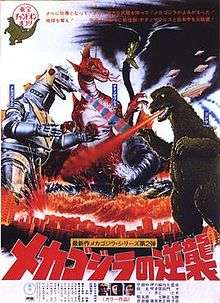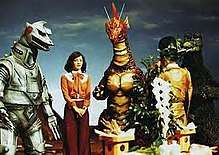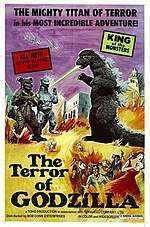Terror of Mechagodzilla
Terror of Mechagodzilla, released in Japan as Mekagojira no Gyakushū (メカゴジラの逆襲, lit. Mechagodzilla's Counterattack) is a 1975 Japanese kaiju film directed by Ishirō Honda, written by Yukiko Takayama, and produced by Tomoyuki Tanaka and Henry G. Saperstein, with special effects by Teruyoshi Nakano. The film was produced and distributed by Toho; it is the 15th film in the Godzilla franchise, serving as a direct sequel to the 1974 film Godzilla vs. Mechagodzilla, and is the final film in the franchise's Shōwa period.
| Terror of Mechagodzilla | |
|---|---|
 Theatrical release poster | |
| Directed by | Ishirō Honda |
| Produced by | Tomoyuki Tanaka Henry G. Saperstein |
| Written by | Yukiko Takayama |
| Starring | Katsuhiko Sasaki Tomoko Ai Akihiko Hirata Katsumasa Uchida Gorō Mutsumi Tadao Nakamaru Toru Kawai |
| Music by | Akira Ifukube |
| Cinematography | Sokei Tomioka |
| Edited by | Yoshitami Kuroiwa |
Production company | |
| Distributed by | Toho |
Release date |
|
Running time | 83 minutes |
| Language | Japanese |
| Budget | $1.2 million[1] |
| Box office | ¥330 million (Japan rentals)[2][3] $20 million (worldwide)[1] |
Terror of Mechagodzilla stars Katsuhiko Sasaki, Tomoko Ai, Akihiko Hirata, and Gorō Mutsumi, and features Toru Kawai, Ise Mori, and Tatsumi Nikamoto as the fictional monster characters Godzilla, Mechagodzilla 2, and Titanosaurus, respectively. The film was released theatrically in Japan on March 15, 1975. It received a limited release in the United States in 1978 by Bob Conn Enterprises under the title The Terror of Godzilla. The film remains the least financially successful entry in the Godzilla franchise to this day.
Plot
Continuing after the end of the events of Godzilla vs. Mechagodzilla, Interpol agents, led by Inspector Kusaka, search for the pieces of Mechagodzilla at the bottom of the Okinawan Sea. Using the submarine Akatsuki, they hope to gather information on the robot's builders, the alien Simeons. The Akatsuki is suddenly attacked by a giant aquatic dinosaur called Titanosaurus and the crew vanishes.
Interpol starts an investigation into the incident. With the help of marine biologist Akira Ichinose, they trace Titanosaurus to a reclusive, mad scientist named Shinzô Mafune, who wants to destroy all mankind. While Ichinose is visiting his old home in the seaside forest of Manazuru, they meet Mafune's lone daughter, Katsura. She tells them that not only is her father dead, but she burned all of the notes about the giant dinosaur (at her father's request). Unbeknownst to them, Mafune is still alive and well. He is visited by his friend Tsuda, who is an aide to the alien leader Mugal. He is leading the project to quickly rebuild Mechagodzilla. Mugal offers their services to Mafune, so that his Titanosaurus and their Mechagodzilla 2 (which is even more powerful than the original) will be the ultimate weapons. They hope to wipe out mankind and rebuild the world for themselves, starting with Tokyo and branching out from there.
But things become complicated for both factions when Ichinose falls in love with Katsura and unwittingly gives her Interpol's information against Titanosaurus, the new Mechagodzilla and the aliens. It is also discovered that Katsura is actually a cyborg, due to undergoing surgery after nearly being killed during one of her father's experiments when she was a child, and Mugal still has uses for her. Meanwhile, Mafune is desperate to unleash Titanosaurus without the aliens' permission, so he releases it on Yokosuka one night. By then, Interpol discovers that supersonic waves are Titanosaurus' weakness. They have a supersonic wave oscillator ready, but Katsura sabotages the machine before they can use it. Fortunately, Godzilla arrives to fight off Titanosaurus and easily defeats him, causing him to retreat back to the sea.
Later, when Ichinose visits Katsura, he is captured by the aliens. Tied up, Ichinose can only watch as Mafune and the aliens unleash Mechagodzilla 2 and Titanosaurus on Tokyo, while Interpol struggles to repair their supersonic wave oscillator and the Japanese armed forces struggle to keep the two monsters at bay. Katsura, while being controlled by Mugal, ignores Ichinose's pleas and controls both the dinosaur and the robot as they destroy the city.
Godzilla comes to the rescue, although at first he is outmatched by the two titans. While Interpol distracts Titanosaurus with the repaired supersonic wave oscillator, Godzilla is able to focus on attacking Mechagodzilla 2. Interpol agents infiltrate the aliens' hideout, rescue Ichinose, and kill Mafune and many of the aliens. The remaining aliens attempt to escape in their ships, but Godzilla shoots them down with his atomic heat ray. The wounded Katsura, while being embraced by Ichinose, shoots herself in order to destroy Mechagodzilla 2's control device (which had been implanted in her body earlier by the aliens). This allows Godzilla to destroy the robot, which short-circuits and is tossed by him into a huge chasm made by the battle, after which Godzilla blasts it with his atomic heat ray, causing it to explode into little pieces of metal again, which are then buried within the chasm at the same time. Godzilla, with the help of the oscillator, then defeats Titanosaurus and heads back to the sea.
Cast
- Katsuhiko Sasaki as Akira Ichinose
- Tomoko Ai as Katsura Mafune
- Akihiko Hirata as Dr. Shinji Mafune
- Katsumasa Uchida as Jiro Murakoshi, Interpol Agent
- Goro Mutusmi as Mugal, Black Hole Alien leader
- Toru Ibuki as Tsuda, Black Hole Alien lieutenant
- Kenji Sahara as General Segawa
- Tadao Nakamaru as Chief of Interpol Tagawa
- Akinori Umezu as boy #1
- Toru Kawai as Godzilla[4]
- Ise Mori as Mechagodzilla 2[4]
- Tatsumi Fuyamoto as Titanosaurus[4]
Production
Development

The original screenplay that Yukiko Takayama created after winning Toho's story contest for the next installment in the Godzilla series was picked by assistant producer Kenji Tokoro and was submitted for approval on July 1, 1974, less than four months after Godzilla vs. Mechagodzilla was released.
The original concept is similar to the finished version of Terror of Mechagodzilla, with many of the changes being budgetary in nature. The most obvious alteration is the removal of the two dinosaurs called the Titans, which merged to become Titanosaurus in the first draft. It was an interesting concept, although something that was also under-explained, considering the magnitude of such an occurrence of the creatures merging. Another noticeable change to the script is that of the final battle, which does not move to the countryside but instead would have reduced Tokyo to rubble during the ensuing conflict between the three monsters.
After her initial draft, Takayama submitted a revised version on October 14, 1974. This went through a third revision on December 4, and then yet another on December 28 of that same year before it was met with approval and filming began.
Filming
The film is one of the only Godzilla films with brief nudity. The scene occurs when Katsura is being operated on in order to have the control devise for Mechagodzilla 2 placed inside her body, at which point Katsura's breasts are exposed (although the body is actually a mannequin). This scene was cut in the U.S., both from the theatrical and TV versions of the film.
Director Ishiro Honda laments not being able to work with the story's writer, Yukiko Takayama, on other films, enjoying that a "woman's perspective was especially fresh" for the genre.
Kensho Yamashita was the chief assistant director on the project. He notes, though, that Honda never actually assigned any of the shooting to him, possibly because he was happy to be directing again after a long gap in his career and wanted to do the work himself.
English version

Toho titled its English version of the film Terror of Mechagodzilla and had it dubbed into English in Hong Kong. This “international version” has never seen wide release in the United States, but has been issued on VHS in the United Kingdom by PolyGram Video Ltd.[6] and on DVD in Taiwan by Power Multimedia.[7]
The film was given a North American theatrical release in March 1978 by independent distributor Bob Conn Enterprises under the title The Terror of Godzilla. Just as Cinema Shares had done with the previous three Godzilla movies, Bob Conn Enterprises chose to utilize the Toho-commissioned English dub instead of hiring a new crew to re-dub the film. The Terror of Godzilla was heavily edited to obtain a "G" rating from the MPAA. Several scenes with violent content were entirely removed, disrupting the flow of the narrative.[8]
Henry G. Saperstein, who sold the theatrical rights to Bob Conn Enterprises, also released the film to television in late 1978, this time under Toho's international title, Terror of Mechagodzilla. Unlike The Terror of Godzilla, the television version remained mostly uncut, with only the shot of Katsura's naked breasts excised. Saperstein's editors also added a 10-minute prologue that served as a brief history of Godzilla, with footage from Saperstein's English versions of Invasion of Astro-Monster and All Monsters Attack (the latter of which utilized stock footage from both Ebirah, Horror of the Deep and Son of Godzilla).[9]
In the mid-1980s, the U.S. television version, Terror of Mechagodzilla, was replaced by the theatrical edit, The Terror of Godzilla, on television and home video. For some reason, the title was also changed to Terror of Mechagodzilla.[10] The 1994 Paramount release of Terror of Mechagodzilla listed a running time of 89 minutes on the slipcase, implying that this release would be the longer version first shown on American TV. The actual video cassette featured the edited theatrical version.[11] In a 1995 interview with G-Fan magazine, Saperstein was surprised to hear about this mistake.[12] In 1997 on Channel 4 in the U.K., three Godzilla movies were shown back to back late at night, starting with Godzilla vs. Megalon, Godzilla vs. Gigan and then Terror of Mechagodzilla; all were dubbed versions. This showing was uncut, including the Katsura nudity scene, but it did not have the Western-made prologue.
In the mid-2000s, the television version showed up again on Monsters HD, and in 2007, it made its home video debut as the U.S. version on the Classic Media DVD. Although the added prologue was originally framed for fullscreen television, it was cropped and shown in widescreen on the disc. The rest of the movie featured the audio from Saperstein's television version synced to video from the Japanese version.[13]
The first article about the movie's storyline was published in a 1977 issue of Japanese Giants (published by Brad Boyle) and was written by Richard H. Campbell, creator of The Godzilla Fan News Letter (a.k.a. "The Gang").
Box office
In Japan, the film sold 980,000 tickets.[14] Despite earning positive reviews, it would be the least-attended Godzilla film in Japan and also one of only two Godzilla films to sell less than 1 million tickets. This was part of a decline in attendance for monster movies as a whole and Toho put the production of monster movies on hold.[15] Toho had no intention of permanently ending the Godzilla series. Throughout the remainder of the 1970s, several new Godzilla stories were submitted by various writers and producers. None of these films, however, were ultimately made.[16] It was not until 1984 and Godzilla's 30th anniversary that Toho would start production on a new Godzilla movie.
Home media
The film has been released several times on DVD in the United States. The first release, by Simitar Entertainment, was on May 6, 1998 in a fullscreen version under the title The Terror of Godzilla. The second release, by First Classic Media and distributed by Sony Music Entertainment, was on September 17, 2002. It was released both individually and as part of the Ultimate Godzilla DVD Collection box set, the latter being released on the same day.
It was then re-released by Second Classic Media, this time distributed by Genius Entertainment, on November 20, 2007 both individually and as part of the Godzilla Collection box set on April 29, 2008.
In 2019, both the Japanese version and the export English version were included in a Blu-ray box set released by the Criterion Collection, which included all 15 films from the franchise's Shōwa era.[17]
References
- Notes
- Edelson, Edward (1980). Great animals of the movies. Doubleday. p. 85.
By the late 1970s, Godzilla films settled down to a comfortable formula. Toho was making two films a year. Each cost in the neighborhood of $1.2 million and could be counted on to earn about $20 million.
- メカゴジラの逆襲
- 歴代ゴジラ映画作品一覧
- Ryfle 1998, p. 361.
- 1974's 'Godzilla vs. Mechagodzilla' is One of the Best of the Series
- Son of Godzilla (1967) and Terror of Mechagodzilla (1975)
- Digital Monster Island - Terror of MechaGodzilla (Power Multimedia / Tailent Video & Multimedia) DVD Review
- Ryfle 1998, pp. 205-206.
- Ryfle 1998, pp. 204.
- Ryfle 1998, pp. 205.
- Kalat 1997, p. 146.
- http://www.historyvortex.org/SapersteinInterview.html
- DVD: Terror of Mechagodzilla (Classic Media)
- Kalat 1997, p. 147.
- Berra 2010, p. 109.
- Ryfle 1998, pp. 215-216.
- Patches, Matt (July 25, 2019). "Criterion reveals the collection's 1000th disc: the ultimate Godzilla set". Polygon. Archived from the original on December 17, 2019. Retrieved July 25, 2019.
- Bibliography
- Berra, John (2010). The Directory of World Films: Japan. Intellect Books. ISBN 9781841503356.CS1 maint: ref=harv (link)
- Kalat, David (1997). A Critical History and Filmography of Toho's Godzilla Series. McFarland & Company. ISBN 0786403004.CS1 maint: ref=harv (link)
- Ryfle, Steve (1998). Japan’s Favorite Mon-Star: The Unauthorized Biography of the Big G. ECW Press. ISBN 1550223488.CS1 maint: ref=harv (link)
- Ryfle, Steve; Godziszewski, Ed (2017). Ishiro Honda: A Life in Film, from Godzilla to Kurosawa. Wesleyan University Press. ISBN 9780819570871.CS1 maint: ref=harv (link)
External links
| Wikiquote has quotations related to: Terror of Mechagodzilla |
- Godzilla on the web (Japan)
- Terror of Mechagodzilla on IMDb
- Terror of Mechagodzilla at AllMovie
- Terror of Mechagodzilla at Rotten Tomatoes
- "メカゴジラの逆襲 (MekaGojira no Gyakushū)" (in Japanese). Japanese Movie Database. Retrieved 2007-07-18.